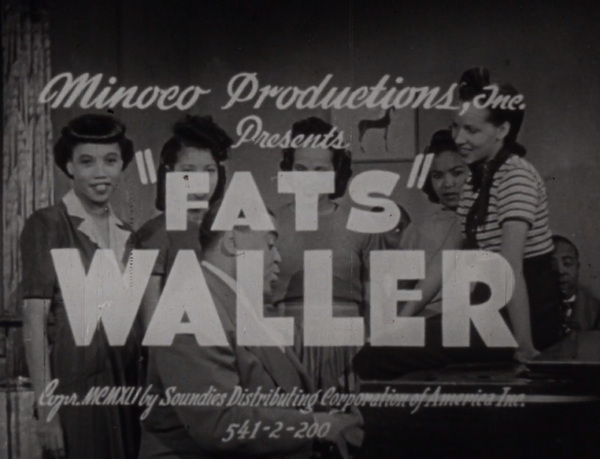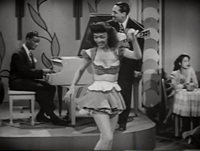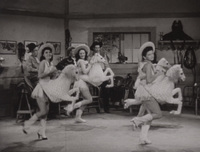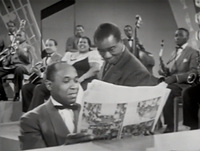All About Soundies
The Panoram machine and its musical short films the machine played, called Soundies, launched in 1940 as a revolutionary film projection system machine aiming to introduce moving image experiences into new areas of public life. The Mills Novelty Company created the Panoram machine, a wooden cabinet base with an 18 by 22 inch glass screen filling the upper wood portion.23 A 16mm projector was mounted within the wooden base and played films upside down towards a mirror placed on the back of the device, which reflected on the glass screen in the correct alignment for viewers.24 At an overall height of 6 ½ feet tall, the Panoram allowed the average adult to be at eye level with the machine while standing. The black and white films were short, generally three minutes or less in duration, and required 10 cents to play.25 On a standard 800 foot reel of film, eight Soundies were included, with regular distributions of new reels from the Soundies Distribution Company. Unfortunately the Panoram lacked individual selection of the Soundies included in the reel, thus if someone wanted to view a particular film they would have to keep paying until it came back around. A new development for commercial film projection machines, Panorams were placed in public places, often in sites of leisure or waiting.26 James Roosevelt, President Franklin Delano Roosevelt’s son and Mills Novelty Company investor, presented the Panoram as a device with a plethora of use locations, including bars, restaurants, train stations, bowling alleys, hotels, and break rooms.27
Key to the Panoram machine was the films shown from its 16mm projector. Referred to as Soundies, these short films focused on music and variety acts, with an emphasis on sound. The Soundies Distribution Company was responsible for creating the films and maintaining regular distribution logistics to the Panoram machines situation across America. Two main production companies partnered with the Soundies Distribution Company to record the actual films. One was Globe Productions, featuring James Roosevelt, which later merged with Sam Coslow’s Cameo Productions to form Roosevelt-Coslow-Mills. This company would be the Soundies’ west coast producer. The east coast Soundies producer, based in New York, was Minoco Productions.28 From 1940 to the end of Soundies production in 1947, over 1,850 films were made.29 Musical styles ranged widely within the catalog, consisting of everything from swing, blues, jazz, country-western, vaudeville-esque comedy and “hillbilly” routines, to Latin American and Hawaiian acts fashioned as “exotic.”30 The Soundies Distribution Company gave Panoram owners the ability to customize their regularly distributed reels, and generally encouraged a variety of musical styles on one reel to engage wide-ranging audience participation.31 Soundies aimed to attract paying audiences through novelty in their productions, which accounted for the frequent vaudeville-inspired acts and the near automatic inclusion of scantily clad (for the era) female dancers and burlesque performers.32 Reliance on the male gaze was prominent in Soundies, with stripteases, burlesque, and women in swimsuits or otherwise scantily-clad to keep attention in what would be referred to as “cheesecake” segments.33 Soundies had a distinct branding to them even between musical styles due to their novelty and regular inclusion of sex appeal.
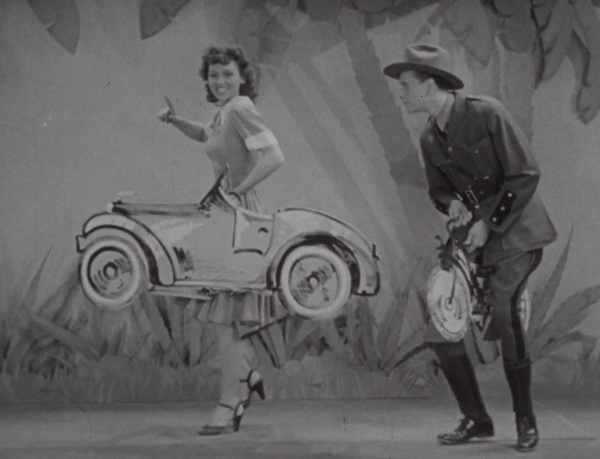
The budget limitations of Soundies were sometimes very apparent.
Variety acts, including impersonations like the one above of Rudy Vallee (a popular singer at the time), were common on Panorams.
Soundies were limited by their production quality, or lack thereof. With tight timelines and low budgets, films were produced at break-neck speed for release to Panoram owners. All expenses factored in, the average Soundie cost $2,000 to $4,000 to make, which equates to about $40,000 to $80,000 in today’s dollars.34 Tight budgets and industrial film production created a basic workflow and a distinctive style. Trying to match the environments where the Panorams were placed, Soundies often took place with similar backdrops to each other to save costs, with many consisting of a spartan set or even just hand-drawn backdrops. Film techniques were specifically implimented to create a sense of intimacy with viewers of the relatively small screen.35 This was achieved through tight camera shots of acts, especially singular performers, and performers giving direct addresses and looks to their would-be audience.36 For efficiency, production companies would select musical acts that already own and regularly perform a selection, and would direct them to record audio in quick order.37 By selecting ready-to-record music and acts, the production companies would save expensive recording studio time. After audio creation, the act would go to the company’s sound stage to capture the visual elements. Film portions were recorded silently, with the act members lip-synching and fake-playing instruments after listening to the previously recorded audio. In contrast to movies, the visuals to Soundies largely lacked narrative and relied on the audio to dictate on-screen actions. The visual elements were created with only a few takes, often resulting in hiccups in the final releases of Soundies where audio and visual aspects are out of sync or look poor in quality, and relied on basic clichés, quick cuts, or sex appeal to keep interest.38 As Jay Migiore, a saxophonist who recorded three Soundies with Gene Krupa, Roy Eldridge, and Anita P’Day ("Let Me Off Uptown," "Thanks for the Boogie Ride," and "After You’ve Gone") remembered the details of the film portion to "Thanks for the Boogie Ride" when interviewed in 1998:
‘Then later, maybe a few days, a week, I don’t recall, we went out to Long Island and did the filming … Anyway, they sat us on the set, and we got to listen to our recording and then act to it a few times before they filmed it … But the other parts, Anita dancing with the policeman and all that, no we weren’t around for that. I do remember the director telling us not to look at the camera, and to try our best to play along with the music, you know, breathe and move our fingers so everything fit.’39
Soundies also relied on smaller artists and acts due to budgets. A musician’s strike from the American Federation of Musicians from August 1942 to November 1944 and a reluctance of major movie stars to contribute to Soundies due to film agents and studio executives being fearful of the potential for Soundies to cut into movie theater revenue, starkly limited the pool of available talent to film.40 Thus a number of smaller, rising stars and minority performers, especially African American musicians, were featured in Soundies. While production values were quite limited, Soundies found audience appeal in their novelty and large variety.
Ultimately unsuccessful, Mills Novelty Company would cease production of Panorams and halt the making of Soundies within a decade of their creation. By the latter portion of 1947, Soundies ceased being made and the Panoram was beginning to be a bygone memory.42 As you will see in more detail through the rest of the exhibit, the reasons for the demise of Soundies and the Panoram were numerous. Some challenges, like U.S. involvement in World War II and a musician strike, were unfortunate happenings largely out of the control of the Mills Novelty Company and its subsidiaries. Others, especially the low budgets, lack of direct selection of programs, and appeal to novelty in films, were the direct result of company decisions. Ultimately Soundies and Panoram machines would find new life in the audiovisual space, and would leave a legacy other technologies would innovate from. To learn more about the afterlife of these technologies, click through to the Legacy of the Soundies.

